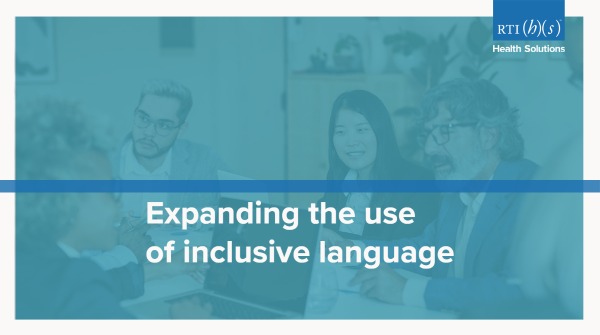One of the cultural pillars at RTI Health Solutions (RTI-HS) is respect for the individual. Throughout the organization, colleagues work to show respect toward others and hold themselves accountable to this principle.
One of the most powerful ways to demonstrate respect—or disrespect—is through the words we use. Language that may seem fine to some can be overwhelmingly disrespectful to others. Due to recent events involving racial violence and the increased focus on gender identity–related terminology, there is a growing awareness of the need for inclusive practices. Given the commitment to respect embedded in the RTI-HS culture, the eagerness to advance language inclusivity in people’s daily work and in their interpersonal communications is not surprising.
 Inspired by their experiences with diversity, equity, and inclusion initiatives, RTI-HS senior medical editors Leila Emery and Joyce Hicks have focused intently on expanding the use of inclusive language in medical writing. Their research found that inclusive language practices help respondents feel validated and enhance data by making it more accurate and robust. They examined recent best practices for language use in medical communications, which flowed into the drafting of an inclusive language section for the RTI-HS language style guide. They also solicited input and feedback from their medical writing and editing colleagues, as well as their fellow Diversity and Inclusion Advisory Council members and RTI’s employee resource groups.
Inspired by their experiences with diversity, equity, and inclusion initiatives, RTI-HS senior medical editors Leila Emery and Joyce Hicks have focused intently on expanding the use of inclusive language in medical writing. Their research found that inclusive language practices help respondents feel validated and enhance data by making it more accurate and robust. They examined recent best practices for language use in medical communications, which flowed into the drafting of an inclusive language section for the RTI-HS language style guide. They also solicited input and feedback from their medical writing and editing colleagues, as well as their fellow Diversity and Inclusion Advisory Council members and RTI’s employee resource groups.
Emery and Hicks emphasize that medical writers and editors should avoid discriminatory or stigmatizing language, increase their awareness of inclusive terminology, and learn to incorporate alternative wording to avoid excluding or demeaning people—even unintentionally.
As part of their work on the Council, they created an Inclusive Language glossary for RTI-HS staff that addresses the nuances of sex, gender identity, sexual orientation, race, and ethnicity, as well as the preferred use of these and related terms in medical writing. Emery shared, “Although categorizing individuals is common practice both in medical diagnosis and scientific research, there are important conceptual differences between these terms that writers should be aware of in their work.” As a way to ensure inclusivity, Emery and Hicks recommend always listening for and respecting a person’s self-identified terminology—the terms a person uses to identify themselves.
They also encourage writers to avoid using loaded terms or words with a troubling history, such as “at risk” to describe communities, individuals, and patients. Instead, “at risk” should be used to describe specific conditions or situations that people experience (for example, patients at risk of developing diabetes; Black patients at risk of developing sickle cell anemia).
Along those same lines, they recommend avoiding terms such as “Blacks” or “Whites” as nouns and instead suggest using these descriptors as adjectives: “Black people” or “White people.” A similar approach applies to terms such as “mixed race” or using “Spanish” to refer to people with Latin American backgrounds. The term “mixed race” is outdated and can be considered derogatory, and the use of “Spanish” as a catch-all term is inaccurate because not all people from Latin America speak Spanish. Using more specific language, such as “biracial” and “multiracial,” or “Puerto Ricans” or “Ecuadorians” is more accurate and appropriate.
Hicks notes that “language and culture are fluid, so we know that this guidance will need to be updated as terminology and norms evolve. We are proud of our work to advance the use and understanding of inclusive language in medical writing. It’s a meaningful way to honor the time and humanity of respondents and patients who make our work possible, while also reflecting the increasingly diverse world around us.”
Emery and Hicks will present on Inclusive Language Best Practices in Medical Writing and Editing at the national American Medical Writers Association (AMWA) conference in Denver on Nov. 5.
